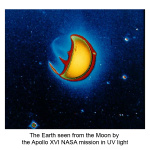RESEARCH

Main research lines are associated with Ultraviolet Astronomy, Astrophysical Plasmas and Star Formation. These activities are coordinated through the Space Astronomy Research Group at UCM: AEGORA, were a full list of activities and publications is included.
As principal investigator of the Spanish participation in the Russian led space mission Spektr-UF/World Space Observatory – Ultraviolet (WSO-UV) most of my activity is concentrated in the development of the Field Camera Unit, WSO-UV imaging instrument, as well as the development of the WSO-UV Science Operations and Science Center in the UCM campus. On the 27th of October of 2017 the Joint Center for Ultraviolet Astronomy (JCUVA) between the Institute of Astronomy of the Russian Academy of Sciences and the Universidad Complutense de Madrid was inaugurated in the UCM campus.
The Spektr-UF/WSO-UV is a multipurpose space observatory consisting of a 1.7 m-aperture telescope and three instruments for high-resolution spectroscopy, long-slit low-resolution spectroscopy, and deep UV and optical imaging. The WSO-UV mission will last for five years with a planned extension of five years more. The foreseen launch date is 2025. The Spanish site of the project can be accessed here. The WSO-UV will provide observations of exceptional importance for the study of several astrophysical problems. The mission has six key scientific objectives:
- The study of galaxy formation and the chemical evolution of the Universe, covering the last 80% of its lifetime (0< z < 2).
- The measurement of the properties of diffuse matter in the Universe and its distribution in galactic haloes.
- The formation and evolution of the Milky Way.The role of discs in astronomical engines.
- The chemical composition and properties of the atmospheres giant extrasolar planets.
- The study of astrochemical processes in UV irradiated environments
Two recent research works are :
Accretion and Intercycle Variations in the PMS Interacting Binary AK Sco.
Gómez de Castro, A.I., Vallejo, J.C., Canet, Ada, Loyd, Parke, France, Kevin
ABSTRACT:
There are only a handful of known short-period pre-main-sequence spectroscopic binaries with significant accretion rates (Class II sources). AK Sco stands out in this list because the system is composed of two equal mass F5 stars in a highly eccentric orbit thus both stars get as close as 11 stellar radii at periastron passage. This configuration is optimal for accretion studies because enhanced accretion events can be precisely timed at periastron passage. In this work, we present the results from the monitoring of the AK Sco system with Hubble during three consecutive periastron passages. These data provide a unique data set to spectroscopically characterize accretion and evaluate the intercycle variability of the system. Clear evidence of accretion rate enhancement was observed in cycles 1 and 3: the blueing of the near-UV continuum, the sudden flux increase of important accretion tracers, such as the N V, Si IV, and C IV lines, and also of neutral/singly ionized species such as O I and C II. Also, variations in the Si III]/C III] ratio reveal an enhancement of the electron density by an order of magnitude during the periastron passage. Moreover, in cycle 3, the spectral resolution of the observations obtained with the Cosmic Origins Spectrograph enabled us to discern that the flow was channeled preferentially into one of the two components. The most remarkable feature in the cycle-to-cycle variations was the detection of a notable increase of the UV flux from cycle 1 to cycle 2 that was not accompanied by enhanced accretion signatures.
Constraints for Use of Ultraviolet Spectropolarimetry to Detect Chiral Amino Acids from Comets
Gómez de Castro, A.I., de Isidro-Gómez, A.I.
ABSTRACT:
Life is pervasive on planet Earth, but whether life is ubiquitous in the Galaxy and sustainable over timescales comparable to stellar evolution is unknown. Evidence suggests that life first appeared on Earth more than 3.77 Gyr ago, during a period of heavy meteoric bombardment. Amino acids, the building blocks of proteins, have been demonstrated to exist in interstellar ice. As such, the contribution of space-generated amino acids to those existing on Earth should be considered. However, detection of space amino acids is challenging. In this study, we used analytical data from several meteorites and in situ measurements of the comet 67P/Churyumov-Gerasimenko collected by the Rosetta probe to evaluate the detectability of alanine by ultraviolet spectropolarimetry. Alanine is the second-most abundant amino acid after glycine and is optically active. This chirality produces a unique signature that enables reliable identification of this amino acid using the imprint of optical rotatory dispersion (ORD) and circular dichroism (CD) in the ultraviolet spectrum (130-230 nm). Here, we show that the ORD signature could be detected in comets by using ultraviolet spectropolarimetric observations conducted at middle size space observatories. These observations can also provide crucial information for the study of sources of enantiomeric imbalance on Earth.

